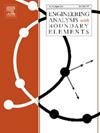用 H2- 加速边界域积分法模拟流体流动
IF 4.2
2区 工程技术
Q1 ENGINEERING, MULTIDISCIPLINARY
Engineering Analysis with Boundary Elements
Pub Date : 2024-11-13
DOI:10.1016/j.enganabound.2024.106015
引用次数: 0
摘要
为流体流动模拟开发新的数值方法极具挑战性,但这些工具有助于更好地理解流动问题。在此,我们采用边界域积分法模拟纳维-斯托克斯方程的无量纲速度-涡度公式控制的层流流体流动。在所有示例中,雷诺数都选得足够小,以确保层流条件。与所有边界元方法一样,边界域积分法具有二次复杂性。与所有边界元方法一样,边界域积分法的复杂度为二次方,而这里采用的 H2 方法的复杂度几乎为线性。这种加速技术不仅适用于边界部分,更重要的是适用于公式中与域相关的部分。H2 方法的应用不允许使用刚体方法来确定奇异积分和自由积分项。本文展示了如何在此应用中应用 Guigiani 和 Gigante 的技术来处理强奇异积分。此外,参数研究显示了引入的近似参数的影响。为此,我们使用了一个盖子驱动空腔的例子。第二个例子通过模拟管道中的哈根-普绪耶流,展示了所提方法的性能。第三个例子考虑了刚性圆柱体周围的流动,以显示该方法在非结构网格中的行为。所有示例都表明,正如数学分析所预测的那样,所提出的方法几乎具有线性复杂性。本文章由计算机程序翻译,如有差异,请以英文原文为准。
Fluid flow simulation with an H2-accelerated Boundary-Domain Integral Method
The development of new numerical methods for fluid flow simulations is challenging but such tools may help to understand flow problems better. Here, the Boundary-Domain Integral Method is applied to simulate laminar fluid flow governed by a dimensionless velocity–vorticity formulation of the Navier–Stokes equation. The Reynolds number is chosen in all examples small enough to ensure laminar flow conditions. The false transient approach is utilized to improve stability.
As all boundary element methods, the Boundary-Domain Integral Method has a quadratic complexity. Here, the -methodology is applied to obtain an almost linear complexity. This acceleration technique is not only applied to the boundary only part but more important to the domain related part of the formulation. The application of the -methodology does not allow to use the rigid body method to determine the singular integrals and the integral free term as done until now. It is shown how to apply the technique of Guigiani and Gigante to handle the strongly singular integrals in this application. Further, a parametric study shows the influence of the introduced approximation parameters. For this purpose the example of a lid driven cavity is utilized. The second example demonstrates the performance of the proposed method by simulating the Hagen–Poiseuille flow in a pipe. The third example considers the flow around a rigid cylinder to show the behavior of the method for an unstructured grid. All examples show that the proposed method results in an almost linear complexity as the mathematical analysis promisses.
求助全文
通过发布文献求助,成功后即可免费获取论文全文。
去求助
来源期刊

Engineering Analysis with Boundary Elements
工程技术-工程:综合
CiteScore
5.50
自引率
18.20%
发文量
368
审稿时长
56 days
期刊介绍:
This journal is specifically dedicated to the dissemination of the latest developments of new engineering analysis techniques using boundary elements and other mesh reduction methods.
Boundary element (BEM) and mesh reduction methods (MRM) are very active areas of research with the techniques being applied to solve increasingly complex problems. The journal stresses the importance of these applications as well as their computational aspects, reliability and robustness.
The main criteria for publication will be the originality of the work being reported, its potential usefulness and applications of the methods to new fields.
In addition to regular issues, the journal publishes a series of special issues dealing with specific areas of current research.
The journal has, for many years, provided a channel of communication between academics and industrial researchers working in mesh reduction methods
Fields Covered:
• Boundary Element Methods (BEM)
• Mesh Reduction Methods (MRM)
• Meshless Methods
• Integral Equations
• Applications of BEM/MRM in Engineering
• Numerical Methods related to BEM/MRM
• Computational Techniques
• Combination of Different Methods
• Advanced Formulations.
 求助内容:
求助内容: 应助结果提醒方式:
应助结果提醒方式:


